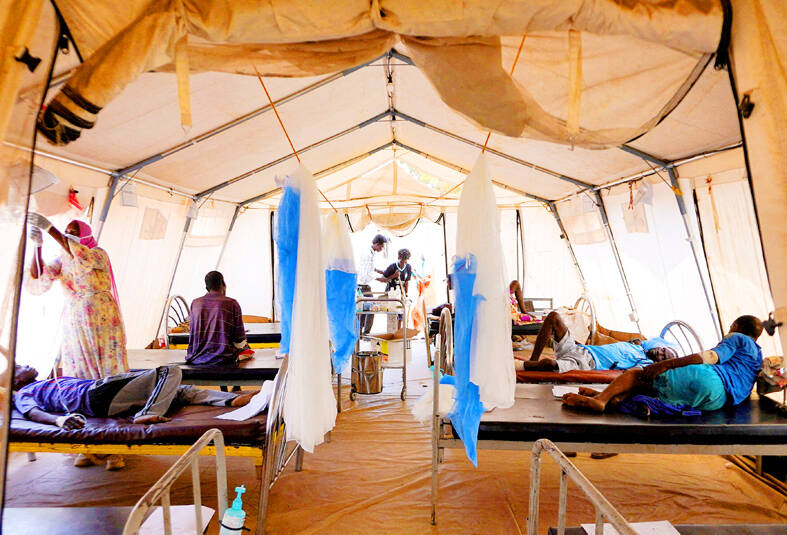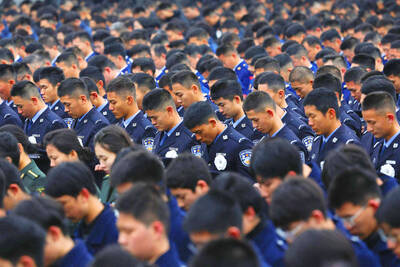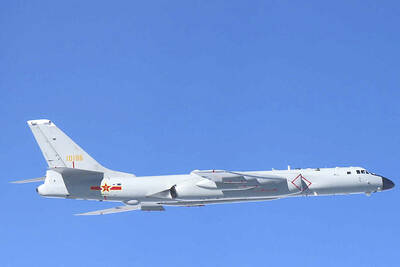Overwhelmed health workers rushed from patient to patient in makeshift tents in Sudan, trying to help even though they too had barely escaped the fall of El Fasher to paramilitary forces.
“We’re not in good shape,” said Ikhlas Abdallah, a general practitioner who arrived from the western Darfur city now in the hands of the Rapid Support Forces (RSF), which have been battling the Sudanese army since April 2023.
“But we have to be okay to provide care to those who need it,” she said.

Photo: Reuters
She spoke from al-Dabbah camp, located in army-held territory about 770km northeast of El Fasher, which endured an 18-month siege before falling to the RSF last month.
“Psychologically, what can we do? Like all those displaced from El Fasher, our feelings are indescribable,” she said.
At the camp, which is funded by a Sudanese businessman, hundreds of families sleep in nylon tents or on plastic mats laid across the sand. In one patch of blue canvas shelters, about 60 doctors, nurses and pharmacists have assembled what passes for a clinic — a makeshift pharmacy, a rudimentary laboratory and tents used as short-stay wards. Plastic chairs serve as examination tables. Ambulances borrowed from the nearby town of al-Dabbah function as mobile clinics.
Men carry buckets of water for the communal kitchens and improvised latrines, while women stir massive pots over open flames. They serve the traditional Sudanese dish assida to families for free.
“We all come from the same place,” said Elham Mohamed, a pharmacist who also fled El Fasher. “We understand them and they understand us.”
Every day, dozens of people arrive with respiratory infections, diarrheal diseases, skin conditions and eye infections — ailments that spread quickly in crowded conditions with little clean water.
“We are doing everything we can, but resources are scarce,” said Ahmed al-Tegani, a volunteer doctor with the International Organization for Migration.
Some patients “require specialized care” that is not available in the camp, he said.
Abdallah fled the Saudi Maternity Hospital in El Fasher after the RSF overran the army’s last stronghold in Darfur on Oct. 26.
She said she arrived safely in al-Dabbah “only because they [the RSF] did not know we were doctors.”
To the paramilitary group, she said, identifying as medical personnel meant “death, captivity or ransom.”
While escaping, she and her colleagues treated the wounded secretly, often without bandages.
“If the RSF discovered someone had received medical care, they beat them again,” she said.
Throughout the conflict, both warring sides have repeatedly and deliberately targeted doctors and hospitals.
The WHO has documented 285 attacks on healthcare since the war began. They have killed at least 1,204 health workers and patients, and wounded more than 400.
Before fleeing, Abdallah spent weeks working around the clock in the maternity hospital. It was the last functioning medical facility in El Fasher and suffered repeated attacks during the siege.
In October alone, the WHO reported four attacks on the hospital.
Abdallah remembers one night in October when a drone struck the building.
“I went home early that evening and later I heard the sound of a drone. It fell on the hospital. When we rushed there, there was no one left to save. Bodies were unrecognizable. People were torn into pieces,” she said. “It didn’t feel real. Horror like in the movies.”
Two days after El Fasher fell, an attack on the hospital killed 460 patients and staff, according to the WHO.
The city remains cut off from communications, with the RSF controlling access to Starlink satellite services.
For Abdallah, the journey to al-Dabbah — which involved checkpoints, arbitrary killings, and rampant looting and sexual violence — was “worse than inside El Fasher.”
Most people “were beaten” and “more people died on the road than” in the city itself, she said.

PARLIAMENT CHAOS: Police forcibly removed Brazilian Deputy Glauber Braga after he called the legislation part of a ‘coup offensive’ and occupied the speaker’s chair Brazil’s lower house of Congress early yesterday approved a bill that could slash former Brazilian president Jair Bolsonaro’s prison sentence for plotting a coup, after efforts by a lawmaker to disrupt the proceedings sparked chaos in parliament. Bolsonaro has been serving a 27-year term since last month after his conviction for a scheme to stop Brazilian President Luiz Inacio Lula da Silva from taking office after the 2022 election. Lawmakers had been discussing a bill that would significantly reduce sentences for several crimes, including attempting a coup d’etat — opening up the prospect that Bolsonaro, 70, could have his sentence cut to

China yesterday held a low-key memorial ceremony for the 1937 Nanjing Massacre, with Chinese President Xi Jinping (習近平) not attending, despite a diplomatic crisis between Beijing and Tokyo over Taiwan. Beijing has raged at Tokyo since Japanese Prime Minister Sanae Takaichi last month said that a hypothetical Chinese attack on Taiwan could trigger a military response from Japan. China and Japan have long sparred over their painful history. China consistently reminds its people of the 1937 Nanjing Massacre, in which it says Japanese troops killed 300,000 people in what was then its capital. A post-World War II Allied tribunal put the death toll

A passerby could hear the cacophony from miles away in the Argentine capital, the unmistakable sound of 2,397 dogs barking — and breaking the unofficial world record for the largest-ever gathering of golden retrievers. Excitement pulsed through Bosques de Palermo, a sprawling park in Buenos Aires, as golden retriever-owners from all over Argentina transformed the park’s grassy expanse into a sea of bright yellow fur. Dog owners of all ages, their clothes covered in dog hair and stained with slobber, plopped down on picnic blankets with their beloved goldens to take in the surreal sight of so many other, exceptionally similar-looking ones.

‘UNWAVERING ALLIANCE’: The US Department of State said that China’s actions during military drills with Russia were not conducive to regional peace and stability The US on Tuesday criticized China over alleged radar deployments against Japanese military aircraft during a training exercise last week, while Tokyo and Seoul yesterday scrambled jets after Chinese and Russian military aircraft conducted joint patrols near the two countries. The incidents came after Japanese Prime Minister Sanae Takaichi triggered a dispute with Beijing last month with her remarks on how Tokyo might react to a hypothetical Chinese attack on Taiwan. “China’s actions are not conducive to regional peace and stability,” a US Department of State spokesperson said late on Tuesday, referring to the radar incident. “The US-Japan alliance is stronger and more